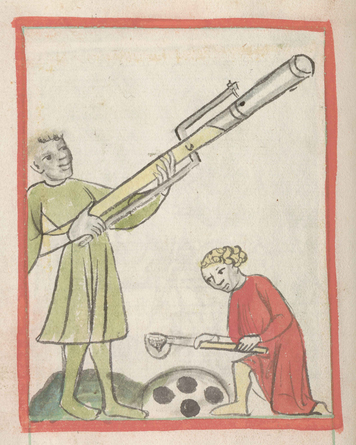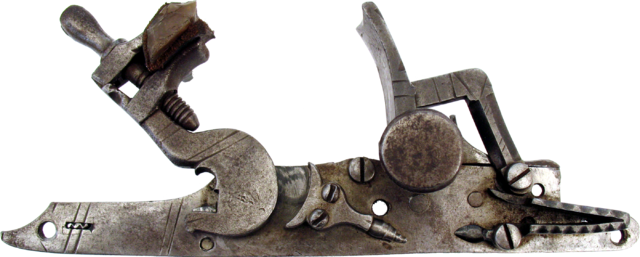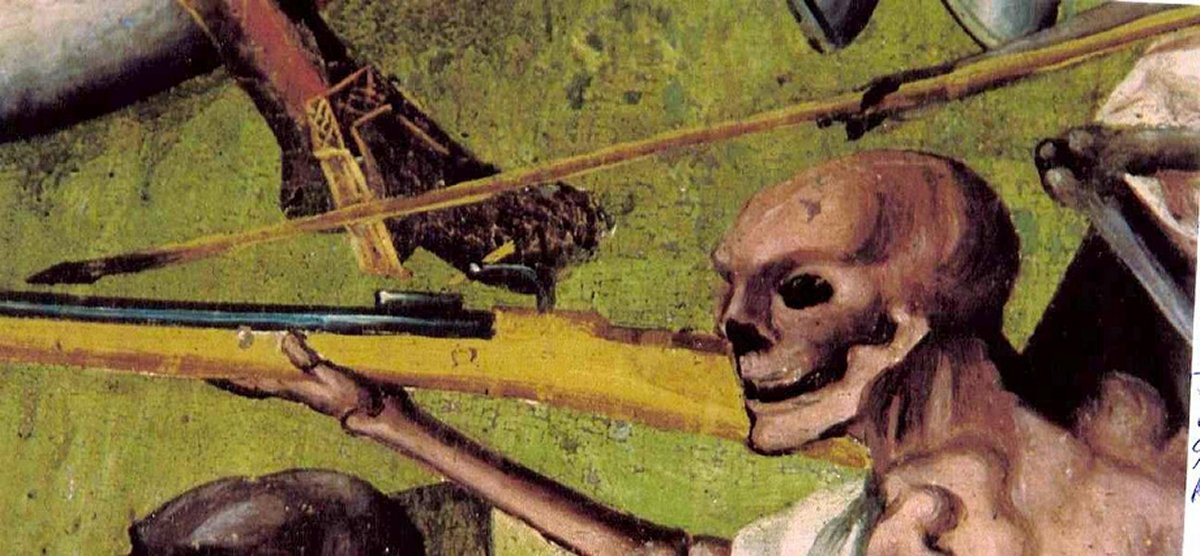| Author |
Message |
|
Dashiell Harrison
Location: California Joined: 14 Jun 2014
Posts: 62
|
 Posted: Sun 14 Mar, 2021 9:15 am Post subject: Earliest use of the matchlock in Europe or Ottoman Empire Posted: Sun 14 Mar, 2021 9:15 am Post subject: Earliest use of the matchlock in Europe or Ottoman Empire |
 |
|
Hi All,
I'm trying to track down the earliest evidence for matchlocks in Europe or the Ottoman Empire. Wikipedia various lists the dates as 1411, 1425, or possible 1394, but I'm hoping that you fine folks might have better information.
I'm also curious to know more about what these early matchlocks were like. Wikipedia cryptically mentions that early serpentines were different from later matchlocks, but doesn't say anything about how.
Finally, can anyone recommend a good book on the early development of Medieval small arms?
Thanks,
Dashiell
|
|
   |
 |
|
Anthony Clipsom
Location: YORKSHIRE, UK Joined: 27 Jul 2009
Posts: 347
|
 Posted: Sun 14 Mar, 2021 9:20 am Post subject: Posted: Sun 14 Mar, 2021 9:20 am Post subject: |
 |
|
| Quote: | | Finally, can anyone recommend a good book on the early development of Medieval small arms? |
Sean McLachlan "Medieval Handgonnes" is pretty accessible and quite cheap.
Anthony Clipsom
|
|
  |
 |
Jean Henri Chandler

|
 Posted: Mon 15 Mar, 2021 3:20 am Post subject: Posted: Mon 15 Mar, 2021 3:20 am Post subject: |
 |
|
| Anthony Clipsom wrote: | | Quote: | | Finally, can anyone recommend a good book on the early development of Medieval small arms? |
Sean McLachlan "Medieval Handgonnes" is pretty accessible and quite cheap. |
I would second that, it's a very good summary of medieval firearms technology and covers most of the better known sources and basics pretty accurately. He does make one mistake at the end of the book where he's talking about joules and muzzle energy in comparison to other weapons, but it's a minor issue compared to the value of the whole book.
As for when the matchlock appears as such indeed depends on how you define "what is a matchlock."
The arquebus itself went through a fairly radical transformation in the 15th Century, as did gunpowder. The gun goes from being kind of a 'zip gun on a stick' circa 1400 to being the recognizable (if still rather crude) firearm with a lock, stock and barrel of the Early Modern era by the 1490s. But the basic elements of a matchlock were all there at the beginning of the century.

You are probably familiar with this image from Johannes Hartleib's Kreigsbuch in 1411. It's a primitive looking firearm but it has a well integrated serpentine. Personally I'd call that a matchlock. And I doubt Hartleib invented it, it seems to have been a known quantity by his time and was probably already around for a generation. The slow-match seems to have been around since the third or fourth quarter of the 14th Century, cannon were documented as being in use in Europe since the late 13th century, and the issue of using hand-gonnes in the field was already a known problem.
This is a description of the use of firearms by the defenders of the Moorish fort called Niebla in 1262:
“..The Arabs threw many (iron) balls launched with thunder,
the Christians were very afraid of, as any member of the body
hit was severed as if with a knife; and the wounded man died
afterwards, because no surgery could heal him, in part
because the balls were hot as fire, and apart of that, because
the powders used were of such nature that any ulcer done
meant the death of the injured man...
.. and he was hit with a ball of the thunder in the arm, and
was cut off, and died next day: and the same happened to all
of those injured by the thunder. And even now the story is
being told amongst the host…”
The weapon was effective, but it was being used mostly in sieges. The reason was that it was so cumbersome to prepare and fire a hand gonne or fire lance as the Chinese called them, it needed to be done behind cover and where a brazier could be kept burning and so on. But once a need was apparent at that time in medieval Europe, it wasn't too long before it was addressed.
Part of the issue is that technology appeared and was disseminated at very different rates in different parts of Europe, so while a weapon like that might be available in Augsburg or Nuremberg in 1411 or even 1390, most armies were probably still relying on simpler touch-hole firearms, or igniting them down the barrel. Another issue is that there were many small elements which went into later firearms which might be considered necessary components of a 'true' matchlock.

During the 15th Century it gradually became common to have a covered priming pan, so that a little jostling of the weapon didn't lose the primer. Then the cover of the priming pan became integrated with the serpentine, another very useful innovation. Then spring loaded serpentines were created, and then the true frizzen, and the snaplock and snaphaunce etc. eventually you have gone from that crude serpentine to something more like this:

Another problem in determining the age of these things is that firearm barrels tend to last a lot longer than the more delicate parts like serpentines, priming pans, and entire locks. So a weapon in a museum or in a private auction which once had a matchlock mechanism may appear to be a simpler touch hole firearm.
My guess though would be ~1380s-1390s in the most advanced places, Nuremberg, Venetian arsenal etc. I don't think they became really widespread probably until the Hussite Wars in the 1420s.
Books and games on Medieval Europe Codex Integrum
Codex Guide to the Medieval Baltic Now available in print
|
|
  |
 |
|
Pieter B.
|
 Posted: Mon 15 Mar, 2021 10:19 am Post subject: Re: Earliest use of the matchlock in Europe or Ottoman Empir Posted: Mon 15 Mar, 2021 10:19 am Post subject: Re: Earliest use of the matchlock in Europe or Ottoman Empir |
 |
|
| Dashiell Harrison wrote: | Hi All,
I'm trying to track down the earliest evidence for matchlocks in Europe or the Ottoman Empire. Wikipedia various lists the dates as 1411, 1425, or possible 1394, but I'm hoping that you fine folks might have better information.
I'm also curious to know more about what these early matchlocks were like. Wikipedia cryptically mentions that early serpentines were different from later matchlocks, but doesn't say anything about how.
Finally, can anyone recommend a good book on the early development of Medieval small arms?
Thanks,
Dashiell |
There's essentially three parts to these early guns; the lock, the stock and barrel. In a broader sense we might regard the 'lock' as the ignition method.
Something like the Tannenberg gun has a barrel about a foot long (though the actual depth of the bore minus the socket and powder chamber is 15.6 cm), is mounted on a stock that is essentially a wooden pole and is ignited by manually holding a smoldering match, hot iron or glowing fungus to the pan/touchole.


A general trend across the 15th century was for the caliber of the barrel to be reduced while the length increased. The lighter weight of the bullet being compensated for a larger powder charge of quicker burning powder which would increase the velocity. As barrels changed in general dimension the stock would also have to be changed to accommodate its usage.
People also started using 'serpentine' or vaguely S shaped levers which could hold a smoldering match used for firing the gun. Needless to say the general length and dimension of these levers had to fit the length of the barrel and the shape of the stock leading to really long levers on short barreled pole mounted weapons whereas others could get away with smaller levers.



At some point some bright locksmith got the idea of making this lever spring operated. It would be pulled back or cocked with a long steel or brass spring pushing against the opposite end of the lever. The serpentine lever itself would be held back by a latchet which the user could open by pressing a button, this would allow the spring to push the end of the serpentine lever holding the glowing match or fungus to strike the pan.



It's really hard to figure out what sources talk about in the 15th century. For example a handheld culverin might be mentioned alongside an arquebus but it isn't clear if the other weapon is referred to as an arquebus because it has a hook underneath to deal with recoil, whether it's the length or bore of the barrel or an ignition system.
As for the word matchlock; in my opinion it is not a matchlock if it isn't spring operated.
| Quote: | Lock springs have played an important role in the design and function of locks throughout history. In the Roman locks, ward springs were used in padlocks and as compression springs in pin tumbler locks. In Scandinavia, ward spring padlocks have been in use from the Viking Era until well into the 18th century. Various types of springs were also used in door locks and chest locks. Prior to 1600 they were V-shaped, while later they could also be rolled, helical springs. Early springs were manufactured of cold-hammered iron, making them quite heavy. Chest locks generally have ring-shaped springs.
Most metal locks have some type of steel springs. A lock spring creates tension – which is usually what the key must displace in order to turn the bolt. Thus, springs store power to perform a task either now or later: pushing forward, holding back or softening a force. Springs have done this kind of work for nearly 2,000 years.
|
https://www.historicallocks.com/en/site/h/locks-and-technology/springs-in-locks/springs-/
If it doesn't have a spring and a sear to cock and hold the serpentine it is not a lock, it is a merely a lever.
When springs were added to guns however is not entirely clear. Many illustrations are simply to vague to tell and some clear(er) examples have a date range that is a decade or two. Personally I think sometime between 1490 and 1500 or 1480 and 1500 is on the mark as people living back then treated matchlocks as some entirely new device in the first decade of the 16th century.
|
|
  |
 |
Jean Henri Chandler

|
 Posted: Mon 15 Mar, 2021 1:40 pm Post subject: Re: Earliest use of the matchlock in Europe or Ottoman Empir Posted: Mon 15 Mar, 2021 1:40 pm Post subject: Re: Earliest use of the matchlock in Europe or Ottoman Empir |
 |
|
| Pieter B. wrote: |
If it doesn't have a spring and a sear to cock and hold the serpentine it is not a lock, it is a merely a lever.
When springs were added to guns however is not entirely clear. Many illustrations are simply to vague to tell and some clear(er) examples have a date range that is a decade or two. Personally I think sometime between 1490 and 1500 or 1480 and 1500 is on the mark as people living back then treated matchlocks as some entirely new device in the first decade of the 16th century. |
Great post and that is a good way to define the criteria. I take back what I said about the Johannes Hartleib gun being a 'matchlock', that makes sense.
Pieter, when would you estimate the serpentine and the slow match first appeared?
Books and games on Medieval Europe Codex Integrum
Codex Guide to the Medieval Baltic Now available in print
|
|
  |
 |
|
Pieter B.
|
 Posted: Mon 15 Mar, 2021 2:57 pm Post subject: Re: Earliest use of the matchlock in Europe or Ottoman Empir Posted: Mon 15 Mar, 2021 2:57 pm Post subject: Re: Earliest use of the matchlock in Europe or Ottoman Empir |
 |
|
| Jean Henri Chandler wrote: | | Pieter B. wrote: |
If it doesn't have a spring and a sear to cock and hold the serpentine it is not a lock, it is a merely a lever.
When springs were added to guns however is not entirely clear. Many illustrations are simply to vague to tell and some clear(er) examples have a date range that is a decade or two. Personally I think sometime between 1490 and 1500 or 1480 and 1500 is on the mark as people living back then treated matchlocks as some entirely new device in the first decade of the 16th century. |
Great post and that is a good way to define the criteria. I take back what I said about the Johannes Hartleib gun being a 'matchlock', that makes sense.
Pieter, when would you estimate the serpentine and the slow match first appeared? |
Good question and I have to say I don't know. You raised another good point that I overlooked.
These guns I showed earlier definitely have a lock mechanism but they weren't fired using a slow match. Michael Trommer raises a very good point about them in this old thread: http://www.vikingsword.com/vb/showthread.php?t=15668
The serpentine itself held a smoldering piece of fungus while the gunners carried a length of very thick slow match around their arm or perhaps wound round their gun.


The thick slow match in contemporary depictions.


A gunner at Pavia with a very substantial smoldering slow match wound round his arm while the serpentine held a much smaller tinder





This makes me wonder exactly what kind of smoldering tinder is shown by Hartleib and other early 15th century depictions, is it a really short and presumably thin slow match or perhaps some fungus like in later lock mechanisms.
It might well be that slow match was something invented in the 14th century while guns with a lock mechanism that were fired using a cord of slow match, as opposed to fungus, were a 16th century thing.
|
|
  |
 |
Jean Henri Chandler

|
 Posted: Tue 16 Mar, 2021 8:43 am Post subject: Posted: Tue 16 Mar, 2021 8:43 am Post subject: |
 |
|
I forgot about the 'smoldering fungus' another good point. And that will definitely be the name of my new Emo band...
Books and games on Medieval Europe Codex Integrum
Codex Guide to the Medieval Baltic Now available in print
|
|
  |
 |
|
Dashiell Harrison
Location: California Joined: 14 Jun 2014
Posts: 62
|
 Posted: Tue 16 Mar, 2021 11:03 am Post subject: Posted: Tue 16 Mar, 2021 11:03 am Post subject: |
 |
|
|
Lot of great information here, thanks guys!
|
|
   |
 |
|
Pieter B.
|
 Posted: Fri 30 Sep, 2022 8:22 am Post subject: Posted: Fri 30 Sep, 2022 8:22 am Post subject: |
 |
|
I am reviving this thread with a question regarding early handguns.
Reading the 'artillery of the dukes of burgundy' by Robert Douglas Smith and Kelly DeVries I was struck by how actual handheld firearms appear only in the administrative records and primary sources from the 1420s onward. Since this concerns Western Europe I suppose there would be a delay before handheld firearms traveled from their point of development in the regions of Southern Germany to the west. In manuscripts from the German speaking region we have solid pictorial evidence dated to the 1400-1410 period.
What I wonder is if we have any early administrative records or ordinances of rulers or towns in Germany regarding firearms at this early date. I was wondering if you every came across anything Jean.
|
|
  |
 |
Randall Moffett

|
 Posted: Sat 08 Oct, 2022 4:47 pm Post subject: Posted: Sat 08 Oct, 2022 4:47 pm Post subject: |
 |
|
Bert Hall's, Renaissance Warfare is an excellent book on the development of handheld firearms as well.
Some great discussion and book recommendations above.
Not much more to add except that when they emerge is different than when they become commonly used.
RPM
|
|
  |
 |
|
|
You cannot post new topics in this forum
You cannot reply to topics in this forum
You cannot edit your posts in this forum
You cannot delete your posts in this forum
You cannot vote in polls in this forum
You cannot attach files in this forum
You can download files in this forum
|
All contents © Copyright 2003-2025 myArmoury.com — All rights reserved
Discussion forums powered by phpBB © The phpBB Group
Switch to the Basic Low-bandwidth Version of the forum
|

